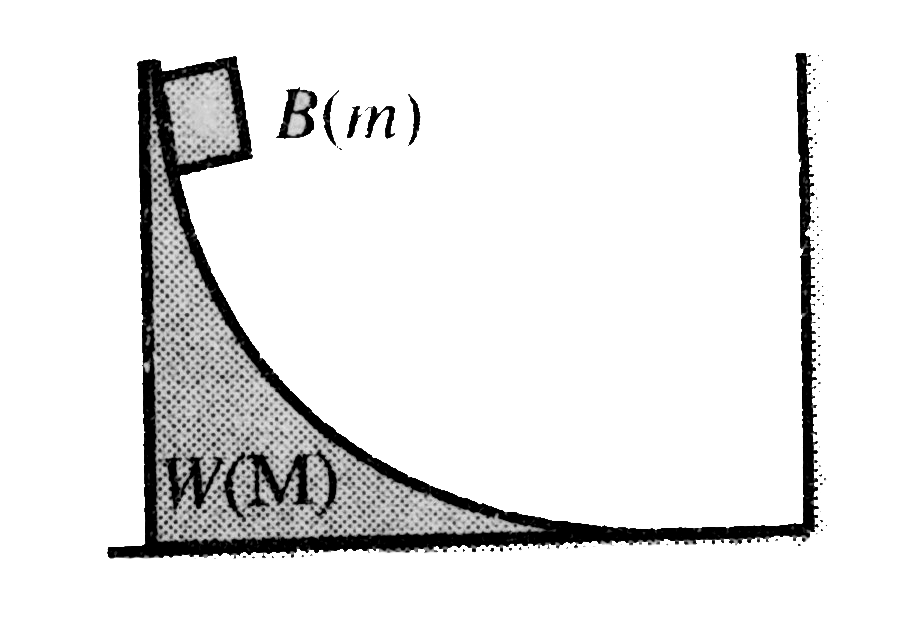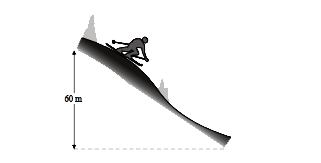In a children's park, there si a slide which has a total length of 10 and a height of 8.0 m figure. Vertical ladder are provided to reach the top. A boy weighting 200 N climbs up the ladder to the top of the slide and slides down to the ground. The averages friction offered by the slide is three tenth of his weight. Find a. the work done by the ladder on the boy as he goes up. b. the work done by the slide on the boy as he comes down. Neglect any work done by forces inside the body of the boy.

The correct Answer is:A, B, C
l=10m,h=8m,mg=200N
F=200xx(3/10)=60N<br>c.Workdo≠bytheladderontheboyiszer⊙<br>Whentheboyisgo∈gup∵theworkisdo≠bythehimself.<br>b.workdo≠aga∈stictioNAlforce,<br>W=murS=fl=(-60)xx10<br>c.workdo≠bytheforce∈siedetheboyis<br>W_b=(mgsintheta)xx10<br>=20xx(8/10)<br>=1600J
Topper's Solved these Questions
Similar Questions
In a children\'s park, there is a slide which has a total length of 10 m and a height of 8.0 m figure. Vertical ladder are provided to reach the top. A boy weighting 200 N climbs up the ladder to the top of the slide and slides down to the ground. The averages friction offered by the slide is three tenth of his weight. Find a. the work done by the ladder on the boy as he goes up. b. the work done by the slide on the boy as he comes down. Neglect any work done by forces inside the body of the boy.
View SolutionA boy weighing 250 N slides down upto the ground from the top of a slide. The friction offered by the slide is three tenth of his weight. The length and height of the slide is 10 m and 8 m, respectively. The work done by the slide on the boy as he comes down to the ground is
View Solution
Knowledge Check
A block of mass 3 kg slides down an inclined plane of length 6 m and height 4 m. if the force of friction on the block is a constant 16 N as it slides from rest at the top of the incline, what is its speed at the bottom?
A2m/sB3m/sC4m/sD5m/sA 2 m ladder leans against a vertical wall. If the top of the ladder begins to slide down the wall at the rate 25 cm/s, then the rate (in cm/s) at which the bottom of the ladder slides away from the wall on the horizontal ground when the top of the ladder is 1 m above the ground is
A25√3B25√3C253D25In the figure, the block B of mass m starts from rest at the top of a wedge W of mass M. All surfaces are without friction. W can slide on the ground. B slides down onto the ground, moves along it with a speed v, has an elastic collision with the wall, and climbs back on to W.
 AFrom the beginning, till the collision with the wall, the centre of mass of 'B plus W' does not move horizontally.BAfter te collision, the centre of mass of B plus W moves with the velocity 2mvm+MCWhen B reaches its highest position of W, the speed of W is 2mvm+MDWhen B reaches its highest position of W, the speed of W is mvm+M
AFrom the beginning, till the collision with the wall, the centre of mass of 'B plus W' does not move horizontally.BAfter te collision, the centre of mass of B plus W moves with the velocity 2mvm+MCWhen B reaches its highest position of W, the speed of W is 2mvm+MDWhen B reaches its highest position of W, the speed of W is mvm+M
A ladder is resting against a wall and a person climbs up the ladder.Is the ladder more likely to slip out at the bottom as the person climbs closer to the top of the ladder? Explain.
View SolutionA skier starts from the top of a hill with speed 5m/s and slides down the hill of vertical height 60 m as shown. Neglect friction. Find his speed at the bottom.

View SolutionIn the figure, the block B of mass m starts from rest at the top of a wedge W of mass M. All surfaces are without friction. W can slide on the ground. B slides down onto the ground, moves along it with a speed v, has an elastic collision with the wall, and climbs back on to W.

View SolutionA block of mass 5 kg slides down a rough inclined surface. The angle of inclination is 45∘. The coefficient of sliding friction is 0.20. When the block slides 10 cm, the work done on the block by force of friction is
View SolutionA block of mass 5 kg slides down a rough inclined surface. The angle of inclination is 45∘. The coefficient of sliding friction is 0.20. When the block slides 10 cm, the work done on the block by force of friction is
View Solution
